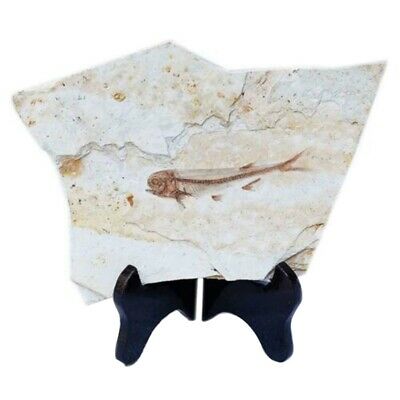-40%
ULTRA Rare Hypsidoris Farsonensis Catfish Fossil Fish Lake Gosiute Wyoming 11"
$ 2901.36
- Description
- Size Guide
Description
There are 2 species of fossil catfish from the Green River Formation in Wyoming. Both are extremely rare.One of the 2 species is named Astephus. These are extremely rare, with a small number being found in each of the 3 major Eocene lakes: Fossil Lake, Lake Gosiute, and Lake Uinta. All are from the Eocene, about 40-50 million years ago.
The other fossil catfish is ever rarer than the Astephus. It is the Hypsidoris Farsonensis, found only in Lake Gosiute Deposits, mostly in the Laney Shale Member, east of Big Sandy Reservoir in Sweetwater County, Wyoming. From the Eocene, about 50 million years old estimated.
This one is a Hypsidoris.
There are only a small handful of Hypsidoris existing in the world, and I do not see any others for sale, anywhere. I have seen, on several occasions through the years, an Astephus being incorrectly labeled as a Hypsidoris. But I personally have not seen another Hypsidoris.
So how do you tell the difference? The answer is found in the masterful book, "Paleontology of the Green River Formation with a Review of the Fish Fauna"- 1984 by Lance Grande. Lance Grande is a top world-class expert on Green River Formation fossils.
Grande wrote, on page 114, "The easiest way to distinguish Hypsidoris from Astephus is by counting anal fin rays: H[ypsidoris] Farsonensis has about 15 to 17 and A[stephus] Antiquus has about 26." That is quite a difference, and fortunately on this specimen, the anal fin rays are clear and distinct.
The anal fin is the last fin on the underside of the fish, before you get to the tail (caudal fin). Count for yourself: I count 15 anal fin rays (photos 9,10,11). Certainly not 26. They are in spectacular condition, none are missing. Please expand all the photos for a better look.
This is a very large specimen. At the time of the 1984 book. 7.9" was considered to be likely the longest these grow, but Grande added "there have not been enough specimens reported to be sure." -p114. Since then, a small number have come to light, with the largest reported being 11.1 inches. I have not seen it. Measuring from the tip of the head to the farthest part of the caudal fin, I get just barely less than 11 inches.
The fish is stunning in that it is so easy to look at.
As with almost all of the catfish from the Laney shale, it is brittle and was found in pieces that had to be expertly restored together. But look at the finished product! Beautiful skeleton, head, vertebrae, fins, caudal (tail) fin (photos 7 and 8), rays, etc. I would suggest you look up any other Hypsidoris and compare.
I see one barbel clearly, in front of the dorsal fin (photo 5), and what may be the start of one or two more on the other side of the fish (covered by matrix).
The plate is about 14.5 inches by about 8.8 inches, and it weighs 5 lbs. 12.9 oz. In the upper left corner of the plate is the back part and caudal fin of a second fish, much smaller, in front of the main catfish. Judging by the anal fin rays visible on it (photo 12), it appears to be a juvenile Hypsidoris traveling with a parent.
This is from an old collection. The catfish-digging area is now restricted and off-limits to the public.
For the serious Green River Formation fossil fish collector, this may be you chance of a lifetime. The bones and and fins and rays, etc., are so easy to see! More than just museum-grade, very few museums own one. Of any quality.
Free shipping.
We are happy to enclose a COA (Certificate of Authenticity) upon request. Some words of warning about COA’s: Do not let them become a substitute for learning about the fossils. We have been working with fossils for many years, and we have seen hundreds of very nice-looking COA’s, some that are flat-out wrong, mis-describing a specimen. In addition, the person selling the item is usually the one who writes the COA (potential conflict of interest). Finally, a COA without a photo of the exact item described, tied to the COA, is worthless, as it can later be placed next to any fish fossil.
COMBINED SHIPPING: We will do our best to combine purchases to save shipping costs. In some cases, that is easy, in some cases not so much. If you buy multiple pieces, and pay for them, we will combine if we can, and refund the shipping difference into your Pay pal account.
We will ship this only to the United States. We are not responsible if the buyer reships it somewhere else, after receiving it from us. Our responsibility ends at the destination we ship it to.
Return Policy: If you are not satisfied with your item, please contact us within 72 hours of receiving the item. We'll refund your purchase price, minus shipping charges, upon safe return of the item in original condition within 30 days of buyer’s receipt of item. Failure to contact us within 72 hours of receipt of item, voids this offer. Buyer is responsible for all return shipping charges. Item must arrive to us in same condition as buyer received it (check photos in original description), or a restocking fee may be charged.
Damage: If your item arrives damaged, please contact us within 24 hours of receiving as we will be happy to resolve any issue. Buyer must contact us within 24 hours of receipt of item to claim damage in shipping.
1710.FGUYFG!FIUG*OUIGOXgogRDXGO E283 storage PHTORM Rck



















